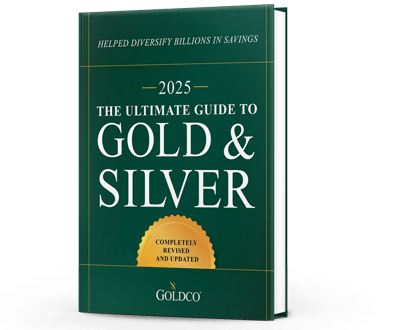4 Things to Watch in Gold Markets Today
With a weakening job market and rising economic uncertainty, more and more Americans are losing confidence in their financial security in the face of growing anxiety about the future With the...
Precious Metals

In their quest to protect their hard-earned wealth, more and more Americans are turning to alternative investments to keep their savings safe and secure. One alternative that has become incredibly popular over the last few years is gold, an asset that has a reputation as a safe haven and store of value.
A popular method of owning gold today is through a gold IRA. Gold IRAs have only existed for about 25 years or so, a mere blip of time when considered against the history of gold’s use. But they’re becoming increasingly popular as a means of protecting retirement savings.
If you’ve been looking at starting a gold IRA, you probably have some questions. Most people do. And one question that’s being asked is whether or not a gold IRA earns interest.
A gold IRA is an individual retirement account (IRA) that holds gold. Most IRA accounts with which you’re probably familiar hold financial assets like stocks, bonds, or shares of funds like mutual funds or exchange-traded funds.
Gold IRAs are a type of self-directed IRA that own physical gold coins or gold bars. Gold IRAs are commonly funded through rollovers or transfers of assets from existing tax-advantaged retirement accounts such as 401(k), 403(b), TSP, IRA, or similar accounts into a gold IRA.
Interest is the amount of money charged for loaning money. If you’re a lender, interest is the amount of money you charge to lend money. If you’re a borrower, interest is the amount of money you pay to borrow money.
The longer you borrow money, the more interest you’ll pay. And the longer you lend money, the more interest you’ll receive.
Looking at this from the perspective of an investor, you’ll generally be told in advance of investing in an asset whether or not it will pay interest and how much interest it will pay. In general, the longer a period of time you hold an asset, the higher its interest rate will be.
The assets you invest in are normally going to be either interest bearing assets or non-interest bearing assets. Most people would think of bonds as the primary interest bearing asset, but they’re not the only ones. Certificates of deposit (CDs), money market accounts, savings accounts, and similar interest-bearing accounts are also examples of interest bearing investments.
With bonds, longer-termed bonds will generally pay a higher interest rate, as the risk of default on the bond increases with time. The same will also normally hold for CDs, with longer-termed CDs paying higher interest rates.
Interest bearing accounts like money market accounts and savings accounts, because they’re demand accounts, generally pay fixed interest rates.
Most other types of assets are non-interest bearing assets. This includes stocks, real estate, and commodities, including precious metals like gold and silver.
While stocks may not pay interest, some stocks pay dividends. Dividends are a distribution of corporate profits to a company’s stockholders.
Let’s imagine Company XYZ which is left with $2 million in profits and 1 million shares of stock outstanding. If the company decides to plow half of that money back into the business and pay half of it to shareholders, it would end up paying $1 of dividends per share. Let’s imagine too that the company’s share price is $20 per share, which would mean that the dividend yield on that stock is 5%.
There are two schools of thought when it comes to stock market investing, growth investing versus value investing. Growth investment is when you try to make money solely through increases in the share price of the stock you own, often by trying to pick stocks in nascent industries that have large potential upside. Value investing is when you try to invest in established stocks that earn dividends in order to make gains from the dividends you receive, with stock price being a secondary concern.
Investing in dividend stocks is popular with many people, and has been popular for decades. Dividend yields are quoted in percentage terms just like interest is, although dividends aren’t actually interest. And there are numerous categories of dividend-earning stocks such as Dividend Aristocrats, Dividend Kings, etc., based on how many consecutive years a company has been issuing and increasing its dividend payouts.
Capital gains distributions are payments made to holders of funds such as mutual funds or exchange-traded funds (ETFs). These distributions represent the gains made from sales of stocks or other assets held by the fund.
Capital gains distributions can come at any time, although normally they’re made towards the end of the year. And capital gains distributions from mutual funds and ETFs are normally treated as long-term capital gains for tax purposes.
These distributions aren’t interest or dividends, nor do you normally calculate the yield of capital gains distributions from a particular fund. But these distributions can add to the gains you make in your funds above and beyond the gains you make from any increases in the fund’s share price.
One thing that many of gold’s detractors like to point out is that gold doesn’t earn interest, dividends, or capital gains distributions. One of those detractors is Warren Buffett, whose company Berkshire Hathaway ironically doesn’t pay a dividend.
There are numerous popular stocks today that don’t pay dividends, such as Amazon and Tesla. Does that make them bad investments? Hardly. The measure of an investment can’t really be made through any objective measure, it’s all about how it suits your particular financial needs.
Some people want the assurance of steady interest payments from highly-rated bonds. They’re happy to bank 5% from Treasury bonds or corporate bonds if it means regular payments and low volatility.
Other people trust that companies that have been issuing ever greater dividends for 50+ years will continue to do so, and choose to invest in dividend earning stocks. And still others invest in companies that don’t issue dividends like Amazon, Tesla, and Facebook, or even smaller and more obscure tech companies, in the hopes of stumbling upon the next Apple or Microsoft.
Gold not earning dividends, interest, or capital gains distributions means that it’s not any different than many stocks out there today. It’s up to you as an investor to determine whether you want to make your gains from interest, dividends, and capital gains, or whether you prefer to make your money from asset price growth.
While gold in a gold IRA may not earn interest, that’s not necessarily a knock against it. Here are five things about a gold IRA that may make you forget about the fact that gold doesn’t earn interest.
Gold has a reputation for maintaining its purchasing power over the long run. While the US dollar has lost 97% of its purchasing power since 1913, gold has gained over 5,000%.
Unlike some financial assets that you may want to get in and out of quickly, gold is generally intended as a long-term investment that can help hedge against trouble and offer stability to your portfolio. Whether that’s 10 years, 20 years, or more, gold can play a role in long-term price growth and stability.
Gold also has a reputation for doing well when the economy isn’t. During the stagflation of the 1970s, for instance, gold’s annualized rate of growth was over 30% per year over the course of the decade. And from 2007 to 2009, when markets lost over 50% of their value, gold gained 25%.
That kind of performance is eye opening once you know about it, which is perhaps why so many people today are trying to buy gold. They remember what happened in 2008 and afterward, and they remember what happened to their investments. And they remember how gold soared while Wall Street tanked.
How many people thought to themselves, “If only I had bought gold earlier!” Many people today buying gold are undoubtedly those who remember what happened the last time around, and they’re trying to make sure that their wealth remains safe during the next recession.
One thing about a gold IRA is that it’s not just about gold. A gold IRA is also sometimes referred to as a precious metals IRA. It’s a type of self-directed IRA that can own and hold other precious metals besides gold.
The four precious metals approved for IRA investment according to the Internal Revenue Code are gold, silver, platinum, and palladium. So if you were interested in buying silver or palladium and not gold, not to worry. Your gold IRA can hold any of those precious metals.
A gold IRA has relatively few things it’s not allowed to invest in. According to the Internal Revenue Code, coins and metals are generally considered collectibles when it comes to IRA investing, which means they’re prohibited from being purchased by an IRA. But there’s a major exception for certain American Eagle gold and silver coins minted by the US Mint, as well as any gold coin with a fineness of .995 or higher.
This means that popular bullion coins like the South African Krugerrand or the Austrian 100 Corona coin aren’t IRA-eligible. But other popular coins like the Canadian Maple Leaf and Austrian Philharmonic are.
In addition, numerous other gold coins are available for IRA investment. Most gold coins today are produced with an eye towards the gold IRA market, and they often have finenesses of .999 or higher. Goldco works directly with mints around the world to bring our customers some of these IRA-eligible gold coins, ensuring that you’ll not only have access to IRA-eligible coins, but also to coins that are guaranteed to be authentic.
Gold IRA assets have to be managed by an IRA custodian, and they’re stored in a bullion depository. That can be advantageous to you if you’re worried about the safety and security of the gold you own.
Gold held outside an IRA might be stored at home, in which case it can be susceptible to theft. Or it might be held in a safe deposit box, which also isn’t necessarily going to be completely safe.
Storage in bullion depositories that have a reputation for security can give you peace of mind that your gold will be there when you need it. Goldco works with established bullion depositories to provide our customers with the storage options they need to keep their gold IRA assets safe.
While a gold IRA may not earn interest, that isn’t necessarily a problem. If you’re an investor who focuses mostly on asset appreciation and thinks of interest, dividends, and capital gains distributions just as nice additions that aren’t completely necessary, then you may feel comfortable owning gold.
Ultimately the decision about whether or not to start a gold IRA is one that you’ll have to make after taking a look at your own financial situation, your financial goals, and the timeline you have to achieve those goals.
Gold IRAs have been helping numerous Americans protect their wealth against inflation and the threat of recession. With the economy showing signs of weakness, and gold becoming more popular as an investment asset, gold IRAs could continue to grow in popularity.
Goldco has helped thousands of customers benefit from owning gold, with over $2 billion in precious metals placements and thousands of 5-star reviews. If you want to learn more about how a gold IRA works and how it can play a role in protecting your wealth, call Goldco today.

